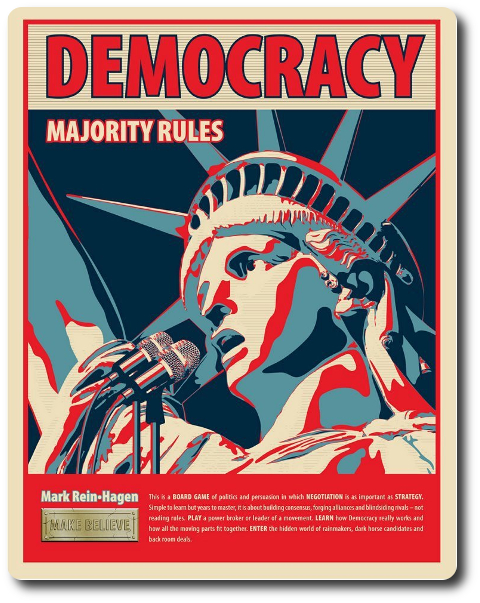
The Basics:
- For ages 10 and up (publisher suggests 12+)
- For 3 to 5 players
- Approximately 60 minutes to complete
Geek Skills:
- Active Listening & Communication
- Counting & Math
- Logical & Critical Decision Making
- Reading
- Strategy & Tactics
- Semi-cooperative Play
- Hand/Resource Management
- Self-confidence
- Worker Placement & Area Control
Learning Curve:
- Child – Moderate
- Adult – Easy
Theme & Narrative:
- Absolute power can be yours, for a price…
Endorsements:
- Gamer Geek mixed!
- Parent Geek mixed!
- Child Geek rejected!
Overview
Aristotle said, “Democracy is when the indigent, and not the men of property, are the rulers.” Change often causes conflict and more times than not is fueled by the unrest of the populace. It’s the politician’s job to listen to their constituents and champion them, passing laws intended to better their lives. In theory. Most of the time, it’s about jockeying for political position, making deals, granting favors, and getting your way. In this game, power may come from the people, but it’s you who will wield it.
Democracy: Majority Rules, designed by Mark Rein-Hagen and published by Make-Believe Games, is comprised of 7 Faction tiles, 1 Politics tile, 1 wooden gavel, 140 Supporter cubes (in 5 different colors, 28 per color), 27 Law cards, 9 Power cards, 30 Ballot card (in 5 different sets, 6 per set), 60 Influence markers, and 60 Political Capital chips (in values 1, 5, and 10). The tiles and chips are made of solid cardboard and durable. The cubes are wood and the markers are plastic. The wooden gavel is not of the highest quality. Ours broke during our playing sessions at the point where the handle meets the head of the gavel. To be fair, the gavel might have broken after being used so many times by players who like to smack the bejesus out of the table. All the cards are made of solid cardstock and are about as thick as your standard playing card.
Getting Ready to Campaign
To set up the game, first place the 7 Faction tiles in the middle of the playing area in a circular pattern with the “Lawmakers” Faction tile in the middle. When placing the tiles, make certain the sides with the white arrows are face-up.
Second, place the Politics tile to one side of the Faction tiles and shuffle the Law cards. When done shuffling, place the Law cards face-down next to the Politics tile. This is the Law draw deck for the duration of the game. Leave room next to it for a discard pile.
Third, give each player 28 Supporter cubes in the color of their choice. Then give each player a set of 6 Ballot cards. Place any unused cubes and Ballot cards back in the game box.
Fourth, each player now places 1 of their Supporter cubes on 1 of the five political roles found on the Politics card . This can be done in order or simultaneously. Each political role can only be taken once (only 1 cube). If playing with an odd number of players (3 or 5 players), at least 1 player must take the “Centrists”, which is placed in the middle of the Politics tile. Players are encouraged to give the “Centrist” role to the least experienced player, since this particular political role has less to gain and to lose, giving the player an opportunity to learn how to play the game without penalizing them for not being familiar with it. In a 3-player game, 2 players take 2 adjacent political roles. For example, a player would take “Liberty” and “Change”, while the other player would take “Tradition” and “Regulate”.
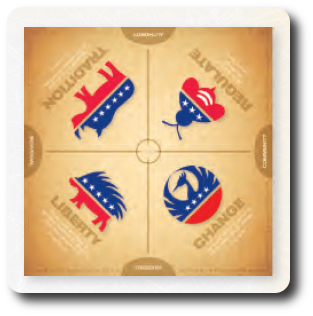
Fifth, shuffle the Power cards numbered 1-5 and deal them out to the players. Then take any remaining Power cards, shuffle, and deal one additional card per player. In a 3-player game, each player will have 3 Power cards. In a 4-player game, each player will have 2 Power cards, but the “Maverick” should not be dealt. If playing a game with 5 players, give the player who only has 1 Power card “1” Political Capital token.
That’s it for game set up. Place the rest of the Political Capital tokens to the side along with the gavel and begin.
On Factions and Power
The Faction tiles and Power cards are, in my opinion, the most important things to consider when playing the game. The Faction tiles give the player leverage and the Power cards give the player the authority to use it. In total, there are 7 factions to choose from and players must win them over by winning supporters. By doing so, the player earns clout in the faction which will be used in the game to hopefully further the player’s goals. Factions are also connected. A player could move their supporter from one faction to another, thus expanding their influence.
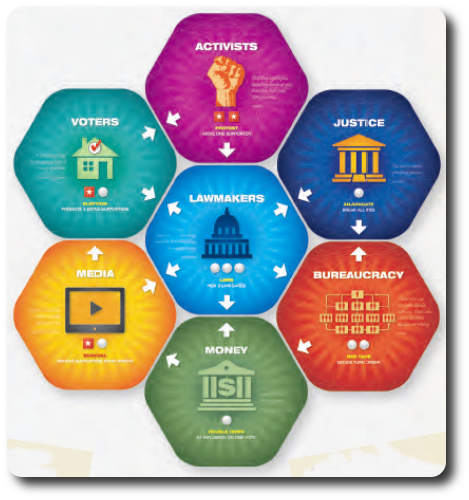
Each faction has a leader who wields the power granted them as best they can to further the faction’s goals. The players will be taking on these roles during the game. Each has its own unique perks that can be used to strategically obtain more supporters, gain influence, and pass laws. But influence over the majority alone does not provide total power. Deals must be made with others, promises given, and favors granted. This is a game about politics, after all.
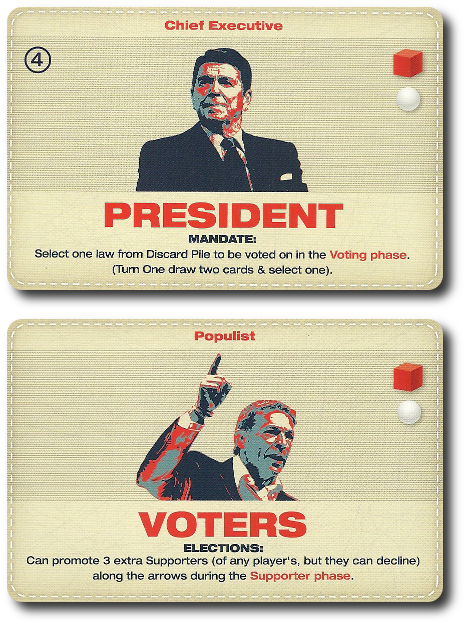
Laws of the Land
The Law cards in the game are voted on and help strength or weaken ties between factions. In game terms, Law cards allow players to make points during several stages of the game and influence the endgame. Thematically, the Law cards force the players to not only compete against opposing factions, but within their own groups, as well. Laws have a subtle impact to the game as a result. Since the lines between factions can sometimes blur, and opportunity for advancement oftentimes trumps alliances, Law cards tend to either strengthen a player’s resolve or weaken it, causing some players to jump factions. During the course of one law being passed, the balance of power between factions can shift dramatically.
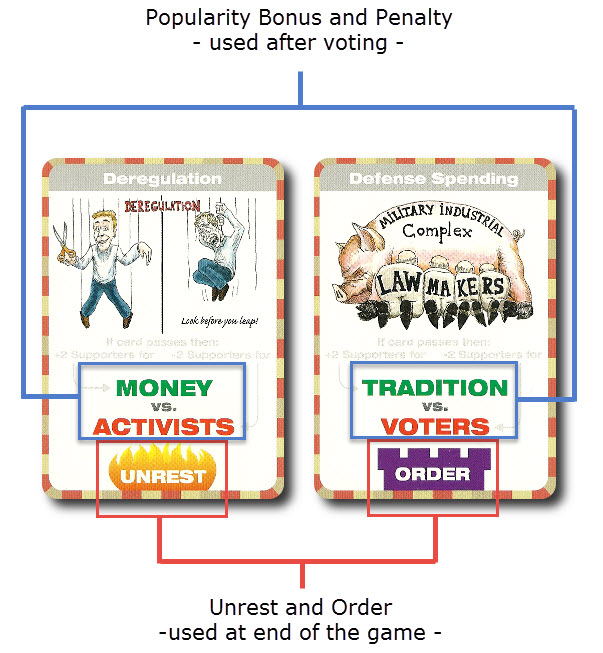
Playing Politics
Democracy: Majority Rules is played in turns. Each turn is broken down into 4 phases. Players will be playing each phase together as a group, meaning there is no player turn order sequence to follow. A typical game turn is summarized here.
Phase 1: Allotments
If this is the game’s first turn, each player collects 6 Supporter cubes and 6 Influence markers. These should be placed in front of the player and away from their other resources to signify that they can be used. On the second and subsequent turns, players will collect an additional 3 Supporter cubes and 3 Influence markers. Players can collect Power cards that provide additional supporters and influence during the game. Players should refer to their cards to make certain they are not missing any bonuses.
Phase 2: Supporters
This phase is broken down into 2 steps.
The first step is to have all the players place their allotted Supporter cubes in one or both of their hands and then select a Ballot card that indicates where the Supporter cubes will be going. If the player is assigning their supporters to only one Ballot card, the Supporter cubes are placed is one hand above the selected face-down Ballot card. If the player is splitting their supporters between 2 Ballot cards, the Supporter cubes are placed in both hands (divided how the player likes) above one face-down Ballot card each. After all the players have selected their Ballot cards, the number of Supporter cubes and all Ballot cards are revealed.
All the players now place their Supporter cubes on the Faction tile that matches the Ballot cards they selected.
The second step is perhaps the most complicated aspect of the game, as it involves making deals and bluffing. Players may now take a Supporter cube on a Faction tile and place it on an arrow on the tile that is pointing to another tile. Only 1 Supporter cube per player per arrow is allowed during this phase. Essentially, the player is saying they will support that particular faction by moving their Supporter cube to the Faction tile the arrow is pointing to, but not yet. First, deals must be made. Supporter cubes will be moved on and off as players attempt to get the best deal and leverage their Power cards. When all the deals have been made, the gavel is struck indicating it’s time to move to the next phase. However, before doing so, several players with Power cards can take additional actions if they like.
One all players have completed taking any additional actions provided by their Power cards, the Supporter cubes are pushed to the Faction tile the arrow they are on points to. Time to see how many friends and enemies you’ve made.
Phase 3: Voting
Now it’s time to vote on new laws. Political alignment, faction membership, and various deals made will influence everyone’s decision.
First, the player who owns the “Head of Lawmakers” Power card draws 5 Law cards. The player does not have to show them to the other players if they do not want to. From these 5 Law cards, 2 are selected to be voted on and are placed face-down. The rest go to the Law discard pile. The player who has the “President” Power card can now selects 1 Law card from the Law discard pile to vote on, handing it to the “Head of Lawmakers”. If this is the first turn, the “President” draws 2 Law cards from the draw deck and selects 1, since there is no Law discard pile yet.
Second, the “Head of Lawmakers” takes the selected Law cards and places them face-up in the order in which they will be voted on. This is referred to as “creating the agenda”.
Third, it’s time to vote. The “Head of Lawmakers” announces which Law card is to be voted on. Players discuss the vote, attempt to persuade each other, give speeches, suggest blackmail, and that sort of thing. Then each player secretly selects a “Yes” or “No” Ballot card and places it face-down in front of them.
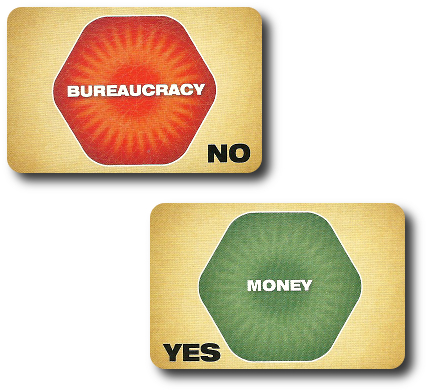
Fourth, all players now reveal their Ballot cards. The table is now split between the “Yes” and “No” groups. Bidding now takes place, starting with the “Yes” group, with 1 or more Influence tokens or nothing at all. Then the “No” group does the same, but the Influence provided must be greater than the total of the other side. This continues until one group can no longer provide Influence to beat the other. When one group drops out, the other can continue to add Influence tokens, jockeying for position within their own ranks.
It should be noted that all the players are contributing to their side, but have their own Influence token pools the are adding to. As a group, all the pools are counted against the opposing group. Individuals in the groups, however, are competing against each other as “top political dog”. In short, you need the support of others to pass or junk a law, but only 1 player gets the glory.
In the event that all players select “Yes” or “No”, it’s obvious if the vote with pass or not, but players still compete to see who the top influencer is.
Fifth, the vote is now resolved. The total influence of both groups is then calculated. The group with the most influence wins the vote, but loses all the Influence tokens they spent. The group with the least influence loses the vote, but gets to keep their Influence tokens.
Sixth, the result of the vote is now resolved.
- Every player with at least 1 Influence token on the winning side receives “1” Political Capital token.
- The player who spent the most Influence tokens on the winning side receives the Law card, placing it in their hand.
- If the Law card passes with a “Yes” vote, the green and red text are now resolved, as well. The player who has the same Power card as the one noted in green receives +2 Supporter cubes. The player who has the same Power cards as the one noted in red is penalized -2 Supporter cubes.
Phase 4: Coalitions
With the shift of power, influence, supporters, and allegiances, it’s time for the players to reform their coalitions. Players negotiate with each other who should be the “Head” of each faction. The best approach is to organize the Supporter cubes on each Faction tile. This allows for everyone to see how many supporters one Faction tile has versus another.
Players now discuss who should lead each coalition with the opponents who also have supporters in the same faction. But not always. Deals can be made in other factions that gives some benefit to another. However it’s done, there must be a consensus within the Faction who will be given the “Head” card. It’s perfectly possible that a player could have more than 1 “Head” card since their Supporter cubes are spread about the tiles.
The “Head” of each Faction is resolved in the following order:
- Justice
- Bureaucracy
- Money
- Media
- Voters
- Activists
- Lawmakers
The idea here is that the player given the “Head” Power card for a faction will use it to benefit those who are also in the same faction. But you know this is not always the case. Each faction is unique, but with players spanning multiple factions, it can often be difficult to determine where one’s allegiances lie.
Once the “Head” of each faction is determined, the following is completed:
- “Head of Activists” may move 1 Supporter from one Faction tile to another Faction tile, following the arrows.
- Each player collects “1” Political Capital token for each Power card they held BUT DID NOT USE during the turn.
- The player who has the most Supporter cubes in the “Voters” and “Media” Faction tiles gets to decide who is awarded the “President” Power card, but they cannot select themselves.
- The “Maverick” Power card is given to the player with the least Political Capital and Power cards in hand.
This ends the turn. A new turn now begins starting with phase 1.
The End of a Political Career
The last turn is triggered when there are no more cards to draw in the Law deck for the next turn. This normally happens at or around turn 5. When there are no more Law cards to draw for the next turn, the game comes to an immediate end.
First, have all players look at the Law cards they collected and count the number of times the words “Unrest” and “Order” are listed.
- If there are more “Unrest” Laws than “Order” Laws, all players discard their Political Capital tokens.
- If there are an equal number of “Unrest” and “Order” Laws, players can only keep as much Political Capital as they have Supporter cubes on the Faction tiles.
- If there are more “Order” Laws than “Unrest” Laws, players add together the Political Capital they’ve collected during the game and any they will collect at the end of the game.
Second, all players now calculate their Political Capital earned at the end of game based on their political accomplishments.
- Earn Political Capital for number of Supporter cubes on Faction tiles
- Earn Political Capital for collecting the most Law cards
- Earn Political Capital for collecting the most “Order” Law cards
- Earn Political Capital for collecting the most “Unrest” Law cards
Players now count up their total Political Capital. The player with the most wins the game!
Game Variants
There are several game variants available right out of the game’s box for those who like to change the game play to fit their needs.
Altered Factions
Each Faction tile is double-sided, with each side providing different number of arrows. The Faction tiles can be placed during game setup however the players like with very few restrictions. Every Faction tile needs to be accessible to at least 1 other Faction tile (otherwise, what’s the point). The initial circle formation is useful, but any shape can be created using the tiles. From there, the sky is the limit. Players are encouraged to set up the Faction tiles to represent different countries and their governments. Players can even develop their own scenarios. For example, play a game where the zombie invasion has begun and the government is now trying to figure out what they should do about it. Debate the rights of zombies, most likely…
Limited Session
The game’s length of play can be changed easily by reducing the number of turns. A short game would be 4 turns in total, while a longer game would be 6 or more.
Role Playing with Robert
A game variant titled “Robert’s Rules of Order” allows players to role-play and experience all the fun and excitement that comes with parliamentary procedures. Experience the thrill of a new session starting as the gavel demands silence, look on in awe as a bill quietly passes or doesn’t, and clap for joy as a motion passes. I’m being totally serious here. If the players want to, rules are provided to make this game about political debate and backroom deals feel like you are actually in a government session.
To learn more about Democracy: Majority Rules, visit the publisher’s Facebook page.
Final Word
The Child Geeks did not get this game. At least, not the younger ones and only a few of our older Child Geeks grasped the meta game well enough to play it to the end. The issues the Child Geeks were having were not based on the rules. The rules of the game are actually very easy. What the Child Geeks had difficulty with was the constant debating, deal making, and faction shifting. In short, the semi-cooperative aspect of the game threw them off. As one Child Geek said, “I’m not sure if I should work with this player or that player. Even if they have a cube in the same Faction tile, I’m not sure I’m supposed to trust them.” And that underlines the main issue. The Child Geeks kept looking for a sign or some other sort of indicator that suggested who they should or should not work with. Of course, there is none. Another Child Geek said, “This is an easy game to learn, but I have no idea how to play it.” When all the Child Geeks played with just their own group, the game fell horribly flat. When they played with their Parent Geeks, they thought the game play was a mixed bag of excitement and total confusion. When all the games were over, the Child Geeks voted to reject the game.
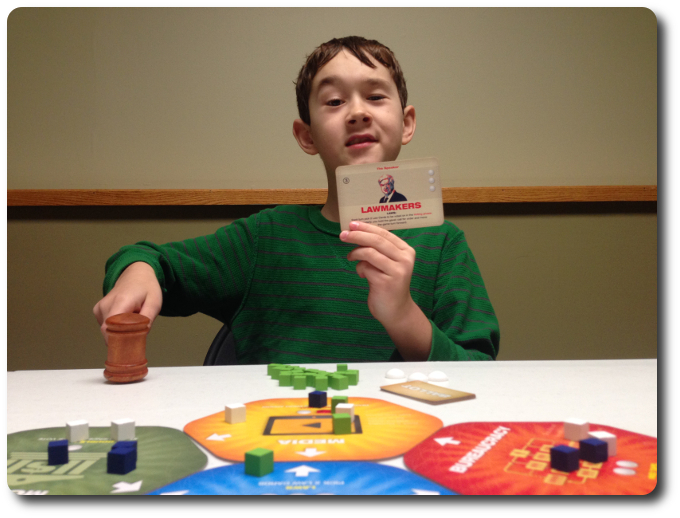
My son, the Lawmaker, loved the gavel. He was terribly corrupt, however…
The Parent Geeks liked the game much more than their children, finding it to be an interesting and entertaining exercise in negotiation and real-time game play. According to one Parent Geek, “You really have to stay on your toes in this game. If you lose track of who is working with who, you might end up going against the wrong person.” Another Parent Geek said, “You can’t do anything in this game without the help of others, which is a bit frustrating when you can’t get them to work with you.” The Parent Geek makes a good point. In this game, many hands are necessary to help the player move their agenda forward. That takes some time to get used to and is not entertaining to everyone. The end vote proved this, with the Parent Geeks having mixed feelings on whether to endorse the game or not. Those who enjoyed the real-time negotiation and communication aspects of the game play applauded it. Those who just wanted to play a game of intrigue, deal making, and hidden agendas were not impressed.
The Gamer Geeks were also mixed and for entirely the same reasons. One Gamer Geek said, “This game has a lot of things going on. A lot. That makes it tricky to play and feel a bit chaotic. I’m not sure that’s what the game’s designer was going for. Either way, I’m not really digging this game.” Another Gamer Geek said, “This is a neat game about negotiation, influence, and playing at politics as I think it should be played. You can team up on others and have others team up on you. You can make alliances and factions in factions. Even your friends are not your friends and your enemy could be a powerful ally. I love this game!” Some did and some didn’t, resulting in a mixed endorsement from the gaming elitists.
Democracy: Majority Rules is positioned as a political game, which it is, but there is more to it. The real heart and focus of this game is player negotiation. In truth, the voting aspect of the game play takes a backseat to the subtle and not so subtle player deals, promises, vague threats, and obvious power grabs sprinkled throughout the game playing session.
I mention this for 2 reasons. First, during our time with this game, it became obvious that the game play was dependent on the players taking the lead. If players do not interact with each, jump up from their chairs from time to time, roll their eyes, scream in frustration, and high-five everyone at the table, they are playing the game wrong. This game wants you to get excited, frustrated, angry, and elated. Failure to “get into the game” makes for a very poor playing experience.
Second, games that require players to get in other players’ faces tend to be a bit too much for some players. Players sometimes have to be aggressive with each other and do things that might make others feel like they are being taken advantage of, lied to, or manipulated. Which they absolutely are, because that’s the game. This should not suggest that you cannot play Democracy: Majority Rules with Child Geeks or non-gamers, however. It’s all about striking the right tone and maintaining a certain level of decorum. When we played with the Gamer Geeks, it was a mud fight from start to finish. When we played with the Child Geeks, it was all about discussing the pros, the cons, and helping younger players see the multiple sides of every coin.
This game has a little bit of everything. From worker placement to semi-cooperative game play. Players have to consider their resources and work to obtain specific areas of control. Wrapped all around this is the negotiation portion, where active listening and communication is key. You would think that a game that provides so much would be disliked by few, but that was not the case. Because the game had so much in it, the individual pieces tended to get swallowed up and diffused by the whole. For players looking for something specific they enjoyed, they had to contend with a whole lot of other things that they weren’t looking for. It’s like Democracy: Majority Rules is a buffet with only one or two items you want to eat. But instead of being able to try just those two things, you are forced to eat the entire buffet.
Democracy: Majority Rules is what you make out of it. Like just about every game under the sun, who you play with oftentimes determines if a game is a “good one” or not. If you got the right group and like a good of negotiation, then do sit down and play a game of Democracy: Majority Rules. While it won’t strengthen your trust in government officials (or friends), it will give you something to talk about.
This game was given to Father Geek as a review copy. Father Geek was not paid, bribed, wined, dined, or threatened in vain hopes of influencing this review. Such is the statuesque and legendary integrity of Father Geek.



